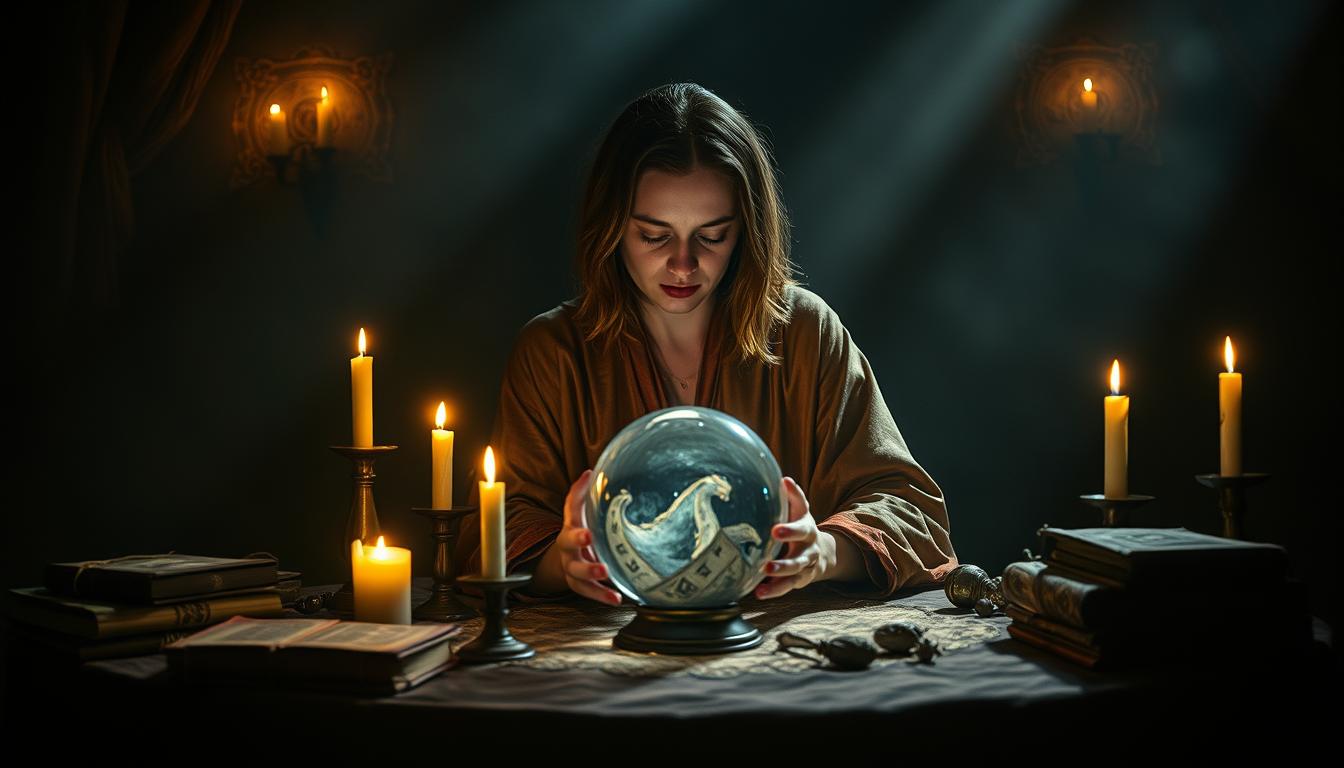Have you ever wondered what it means to be a clairvoyant? The term clairvoyance comes from the French words “clair” (clear) and “voyance” (vision), referring to the ability to perceive things beyond ordinary sense. A clairvoyant is often described as a person who can gain insights about the present, past, or even the future through their intuitive power.
This practice has roots in ancient mystical traditions and has fascinated people for centuries. While some claim it’s a genuine ability, scientific research often views it with skepticism, attributing it to bias or self-delusion. Despite this, clairvoyant readings remain popular today, with many seeking clarity on life’s big questions.
From historical figures to modern TV shows, clairvoyance continues to capture the imagination. Whether you’re curious about its history or how it works, this article will explore the fascinating world of clairvoyant readings.
Key Takeaways
- Clairvoyance means “clear vision” and involves perceiving information beyond normal senses.
- It has historical roots in mystical traditions and remains culturally relevant today.
- Scientific research often views clairvoyance with skepticism.
- Readings can provide insights into the past, present, or future.
- Clairvoyant practices are popular in modern media and personal growth.
Introduction to Clairvoyance and Its Historical Roots
Clairvoyance has intrigued humanity for centuries, blending mystery and spirituality. This unique ability to perceive beyond ordinary senses has roots in ancient cultures, where it was often seen as a divine gift. From oracles in Greece to spiritual seers in Egypt, clairvoyance has played a significant role in shaping beliefs and traditions.
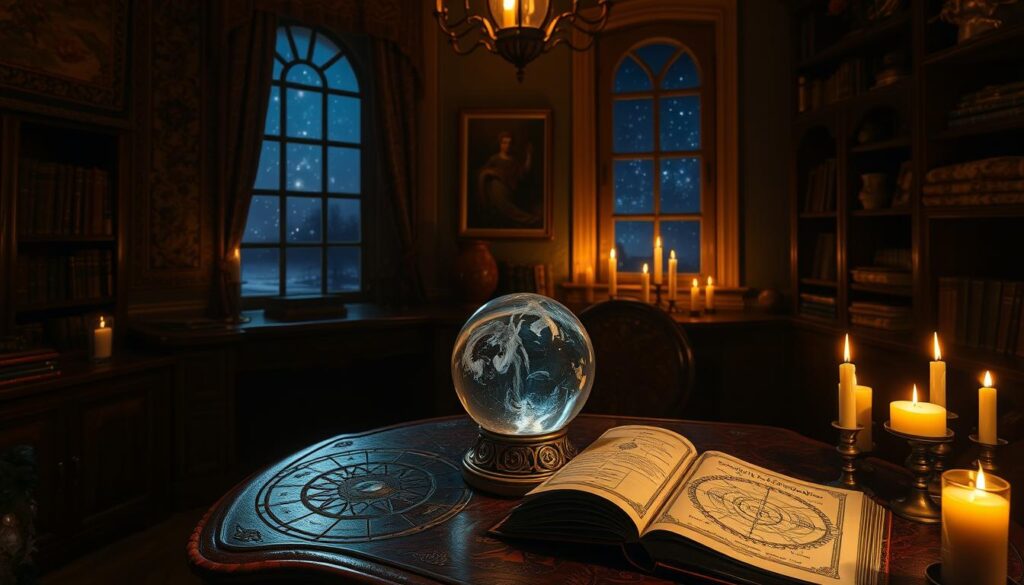
Origins and Evolution of Clairvoyant Practices
In ancient times, clairvoyance was closely tied to religious and spiritual practices. Oracles, like the famous Oracle of Delphi, were consulted for guidance on important events. These seers were believed to have a direct connection to the divine, offering insights into the future or hidden truths.
Over the centuries, clairvoyant practices evolved. Mediumship gained popularity in the 19th century, with figures like Eusapia Palladino captivating audiences. Today, clairvoyance remains a sought-after practice, blending ancient traditions with modern interpretations.
Paranormal Claims vs. Scientific Skepticism
While many believe in the ability of clairvoyants to see beyond the ordinary, scientific research often views these claims with skepticism. Experiments by J.B. Rhine in the 1930s aimed to test clairvoyance under controlled conditions. However, the results were inconclusive, leading to ongoing debates.
Modern science continues to explore the boundaries of human perception. Some argue that clairvoyance may be a result of heightened intuition or subconscious processing. Others dismiss it as coincidence or bias. Despite the skepticism, the fascination with clairvoyance persists, offering a unique blend of history, mystery, and personal experience.
For more insights into the world of clairvoyance, visit our detailed guide.
Techniques and Methods Used in Clairvoyant Readings
The methods used in clairvoyant readings are as diverse as the individuals who practice them. From intuitive insights to symbolic tools, clairvoyants employ a variety of techniques to tap into information beyond ordinary senses. These methods often blend ancient traditions with modern interpretations, creating a unique experience for those seeking guidance.
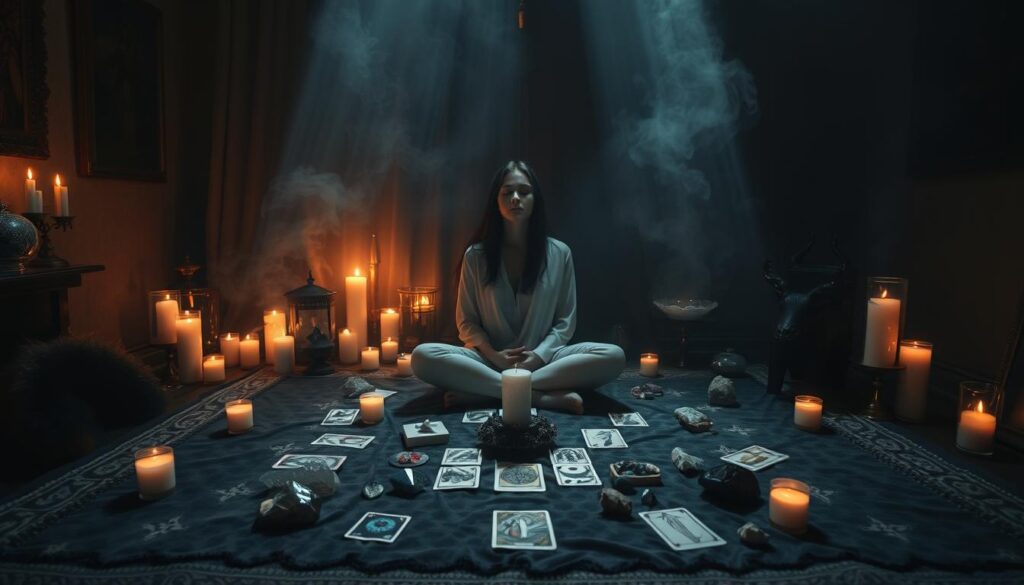
Mediumship, Remote Viewing, and Other Approaches
One of the most well-known techniques is mediumship, where a person acts as a bridge between the physical and spiritual worlds. Mediums claim to communicate with spirits, offering insights into the past, present, or future. Another fascinating method is remote viewing, which involves perceiving distant or unseen locations. Studies at Duke University, led by researchers like Puthoff and Targ, explored this phenomenon, though results remain debated.
Remote viewing gained attention during the Cold War for its potential applications. While some experiments showed promising results, the rate of success varied, leaving room for skepticism. Despite this, many practitioners believe in the power of remote viewing as a genuine clairvoyant ability.
Tools of the Trade: Cards, Symbols, and Visions
Clairvoyants often use symbolic tools to enhance their readings. Tarot cards are a popular choice, with each card representing different aspects of life. The Celtic Cross and Three Card Spread are common layouts used to address specific questions or situations. Crystal balls, another traditional tool, are used for scrying—a practice where visions are interpreted to gain insights.
Symbols and visions play a significant role in clairvoyant readings. Practitioners often describe seeing images or receiving messages in their mind, which they then interpret for their clients. These methods rely on a combination of intuition and symbolic language, creating a structured yet mystical approach to readings.
Whether through mediumship, remote viewing, or symbolic tools, clairvoyant readings offer a unique blend of intuition and tradition. While scientific validation remains elusive, the fascination with these techniques continues to captivate those seeking answers beyond the ordinary.
Exploring Clairvoyants and Their Abilities
The debate around clairvoyance often centers on its validity and the challenges of proving it scientifically. Many individuals claim to possess this unique ability, but their experiences often face scrutiny in controlled environments. Let’s take a closer look at the person behind the claims and the scientific perspectives that shape our understanding.
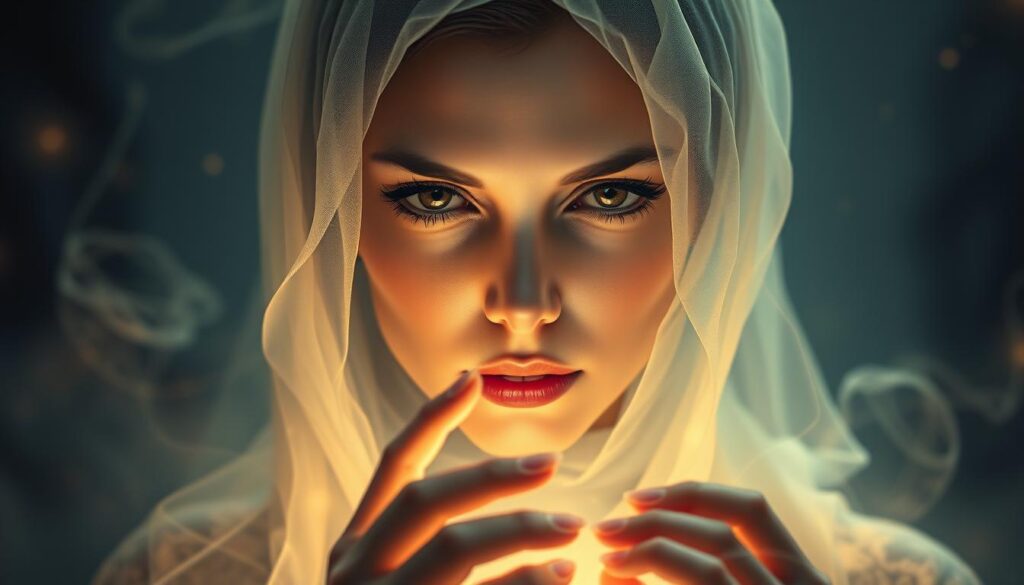
Scientific Perspectives and Methodological Challenges
Scientific research on clairvoyance has been ongoing for decades. Studies by researchers like Cox, Marks, and Randi aimed to test these claims under controlled conditions. However, the results were often inconclusive or failed to replicate. For example, experiments designed to test remote viewing showed a low rate of success, leading many to question its validity.
One major challenge is sensory leakage, where participants might unconsciously gather information through normal senses. Another issue is confirmation bias, where people tend to remember hits and forget misses. These factors make it difficult to isolate genuine clairvoyant abilities from chance or error.
Skepticism, Bias, and the Quest for Evidence
Despite the fascination with clairvoyance, skepticism remains widespread. Many scientists regard it as a pseudoscience due to the lack of reproducible evidence. For instance, the famous Randi experiments exposed several cases where clairvoyants failed to demonstrate their abilities under strict controls.
However, some argue that the scientific methods used may not fully capture the nature of clairvoyance. They suggest that traditional experiments might not account for the intuitive and subjective aspects of this ability. This ongoing debate highlights the complexity of studying phenomena that lie beyond ordinary perception.
Whether you’re a believer or a skeptic, the exploration of clairvoyance offers a fascinating glimpse into the boundaries of human perception and the challenges of scientific inquiry.
Clairvoyant Readings: What to Expect in a Session
Curious about what happens during a clairvoyant reading? Let’s walk through the experience step by step. Whether you’re a first-timer or a seasoned seeker, understanding the process can help you feel more at ease and prepared.
Setting the Stage: Environment and Atmosphere
The place where a reading takes place plays a big role in setting the tone. Most clairvoyants create a calming environment with soft lighting, comfortable seating, and soothing elements like candles or incense. This helps both the person giving the reading and the client relax and focus.
Many practitioners also use tools like tarot cards, crystals, or scrying mirrors to enhance their ability to connect. The goal is to make the space feel welcoming and safe, allowing you to open your mind to the experience.
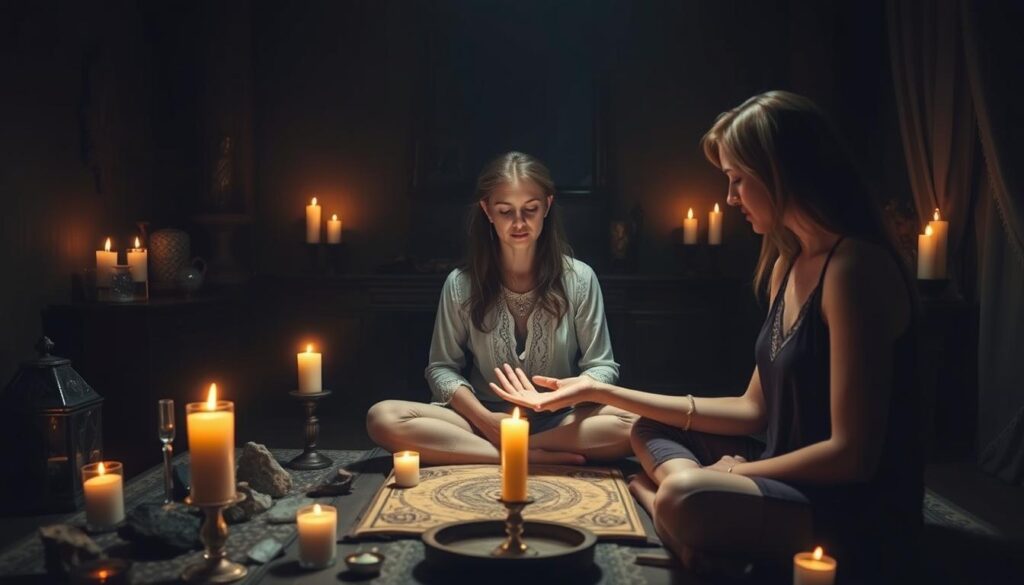
Understanding the Flow of a Reading Session
A typical session begins with a warm greeting and a brief conversation. The clairvoyant may ask about your intentions or any specific questions you have. This helps them focus their sense of intuition on what matters most to you.
As the reading progresses, the clairvoyant will share insights, often blending symbolic interpretations with intuitive impressions. You might hear terms like “energy,” “vibrations,” or “visions” as they explain what they perceive. The results can vary—some clients receive clear guidance, while others gain a deeper understanding of their current situation.
By the end of the session, you’ll likely feel a mix of emotions, from clarity to curiosity. Many clairvoyants encourage clients to take notes or reflect on the messages they’ve received. This helps ensure the experience stays meaningful long after the session ends.
Whether you’re seeking answers or simply exploring your curiosity, a clairvoyant reading is designed to be a respectful and personalized encounter. Today’s practitioners often adapt traditional methods to meet modern expectations, making the process accessible and relevant.
Media and Cultural Impact on Clairvoyance
The rise of clairvoyance in popular culture has transformed it from a mystical practice to a mainstream phenomenon. Television, live shows, and online media have played a significant role in bringing clairvoyant acts into the spotlight. From reality TV to Las Vegas residencies, these platforms have shaped how the public perceives this unique ability.
From America’s Got Talent to Vegas Headliners
One of the most notable examples is The Clairvoyants, a duo that gained fame on America’s Got Talent. Their performances, blending intuitive power with theatrical elements, captivated audiences and judges alike. Their success led to a Las Vegas residency at the Luxor Hotel & Casino, cementing their place in entertainment history.
Media outlets like the New York Times and LN News have covered their journey extensively. “We wanted to show that clairvoyance isn’t just about mysticism—it’s also about connecting with people,” they shared in an interview. This blend of genuine belief and staged magic has made their act both intriguing and accessible.
The Role of Media in Shaping Perceptions
Media plays a dual role in the world of clairvoyance. On one hand, it amplifies the ability of clairvoyants, turning them into household names. On the other, it scrutinizes their claims, often questioning the authenticity of their power. Shows like America’s Got Talent and documentaries on paranormal phenomena have sparked debates about what is real and what is entertainment.
Live performances often incorporate tools like cards and symbolic acts, adding a layer of spectacle. These elements not only enhance the rate of audience engagement but also contribute to the public image of clairvoyance as a form of entertainment. Whether it’s a televised performance or a Vegas show, the media’s fascination with clairvoyance continues to grow.
This cultural shift has brought clairvoyant acts to the forefront of live entertainment. From historical roots to modern stages, the journey of clairvoyance reflects a fascinating interplay between belief, skepticism, and the power of media.
Conclusion
From ancient oracles to modern media, clairvoyance remains a topic of intrigue and debate. Its journey spans centuries, blending mystical traditions with today’s fascination. Whether through tarot cards, mediumship, or remote viewing, the techniques used by clairvoyants continue to captivate those seeking answers beyond the ordinary.
Scientific research has faced challenges in validating these claims, with studies often yielding inconclusive results. Despite skepticism, the cultural impact of clairvoyance is undeniable. Media platforms like America’s Got Talent have brought it into the spotlight, shaping public perception and sparking conversations about its reality.
As you explore this fascinating world, consider the balance between belief and evidence. Whether you’re a skeptic or a believer, clairvoyance offers a unique lens into the mysteries of life. For more insights, visit our detailed guide and stay open to the possibilities that lie beyond the ordinary.

